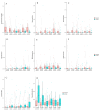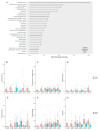Effect of a 6-Month Functional Food Intervention on the Microbiota of Stunted Children in East Nusa Tenggara, Indonesia-A Randomized Placebo-Controlled Parallel Trial
- PMID: 40646970
- PMCID: PMC12248618
- DOI: 10.3390/foods14132218
Effect of a 6-Month Functional Food Intervention on the Microbiota of Stunted Children in East Nusa Tenggara, Indonesia-A Randomized Placebo-Controlled Parallel Trial
Abstract
We have previously shown a difference between the gut microbiota composition of stunted and non-stunted children in East Nusa Tenggara, Indonesia. The current study aimed to perform an intervention with a probiotic, Lactiplantibacillus plantarum IS-10506, and its UHT-treated postbiotic compared to placebo in order to accomplish catch-up growth in the stunted children, possibly through modulation of the gut microbiota. Apart from the maltodextrin (placebo), probiotic, and postbiotic in chocolate milk, all groups also received a functional and nutritional biscuit and had access to newly constructed water wells as well as soap to improve hygiene. The results show that independent of treatment, the stunted children had a significantly higher increase in height and zlen (corrected for age) compared with their age- and gender-matched controls but a significantly lower increase in weight. Several potential pathogenic taxa declined in all groups, among which was Escherichia/Shigella (adjusted.p = 6.44 × 10-15), but so did some beneficial taxa, such as Bifidobacterium and Akkermansia. Faecalibacterium, which was already higher in the stunted children at baseline, increased independent of treatment. Changes in the relative abundance of several taxa of the microbiota correlated with the changes in anthropometric measures. In conclusion, although there was no difference between the interventions, understanding the dynamics and the role of the gut microbiota in this process might allow healthcare providers to develop targeted nutritional strategies aimed at optimizing health outcomes for children at risk of stunting, thereby addressing a critical global health issue.
Keywords: Faecalibacterium; Indonesian children under 5 year; SCFA; butyrate; gut microbiota; nutritional status; stunted.
Conflict of interest statement
Author Koen Vennma is founder and CEO of the company Beneficial Microbes Consultancy. This company was not involved in set-up or funding of the study. The remaining authors declare that the research was conducted in the absence of any commercial or financial relationships that could be construed as a potential conflict of interest.
Figures





Similar articles
-
Gut microbiota differences in stunted and normal-lenght children aged 36-45 months in East Nusa Tenggara, Indonesia.PLoS One. 2024 Mar 29;19(3):e0299349. doi: 10.1371/journal.pone.0299349. eCollection 2024. PLoS One. 2024. PMID: 38551926 Free PMC article.
-
Nutritional interventions for survivors of childhood cancer.Cochrane Database Syst Rev. 2016 Aug 22;2016(8):CD009678. doi: 10.1002/14651858.CD009678.pub2. Cochrane Database Syst Rev. 2016. PMID: 27545902 Free PMC article.
-
Systemic pharmacological treatments for chronic plaque psoriasis: a network meta-analysis.Cochrane Database Syst Rev. 2017 Dec 22;12(12):CD011535. doi: 10.1002/14651858.CD011535.pub2. Cochrane Database Syst Rev. 2017. Update in: Cochrane Database Syst Rev. 2020 Jan 9;1:CD011535. doi: 10.1002/14651858.CD011535.pub3. PMID: 29271481 Free PMC article. Updated.
-
Systemic pharmacological treatments for chronic plaque psoriasis: a network meta-analysis.Cochrane Database Syst Rev. 2021 Apr 19;4(4):CD011535. doi: 10.1002/14651858.CD011535.pub4. Cochrane Database Syst Rev. 2021. Update in: Cochrane Database Syst Rev. 2022 May 23;5:CD011535. doi: 10.1002/14651858.CD011535.pub5. PMID: 33871055 Free PMC article. Updated.
-
Sertindole for schizophrenia.Cochrane Database Syst Rev. 2005 Jul 20;2005(3):CD001715. doi: 10.1002/14651858.CD001715.pub2. Cochrane Database Syst Rev. 2005. PMID: 16034864 Free PMC article.
References
-
- WHO Child Growth Standards and the Identification of Severe Acute Malnutrition in Infants and Children—A Joint Statement by the World Health Organization and the United Nations Children’s Fund. World Health Organization; Geneva, Switzerland: 2009. [(accessed on 11 January 2024)]. World Health Organization. Available online: https://www.who.int/publications/i/item/9789241598163. - PubMed
-
- Chibuye M., Mende D.R., Spijker R., Simuyandi M., Luchen C.C., Bosomprah S., Chilengi R., Schultsz C., Harris V.C. Systematic review of associations between gut microbiome composition and stunting in under-five children. npj Biofilms Microbiomes. 2024;10:46. doi: 10.1038/s41522-024-00517-5. - DOI - PMC - PubMed
-
- Siramaneerat I., Astutik E., Agushybana F., Bhumkittipich P., Lamprom W. Examining determinants of stunting in Urban and Rural Indonesian: A multilevel analysis using the population-based Indonesian family life survey (IFLS) BMC Public Health. 2024;24:1371. doi: 10.1186/s12889-024-18824-z. - DOI - PMC - PubMed
Grants and funding
- 022/E4.1/AK.04.PRN/2021/National Research Priority (PRN) Scheme, Directorate General of Higher Education, Research, and Technology, Ministry of Education, Culture
- 89/IV/KS/11/2022/Research and Innovation for Avanced Indonesia (RIIM) Scheme, National Research and Innovation Agency (BRIN), Indonesia
- World Class Professor 2023 Program, Directorate of Human Resources, Directorate General of Higher Education Research and Technology, Ministry of Education, Culture Research and Technology, Indonesia
- HEFI-1/Dutch Province of Limburg
LinkOut - more resources
Full Text Sources

